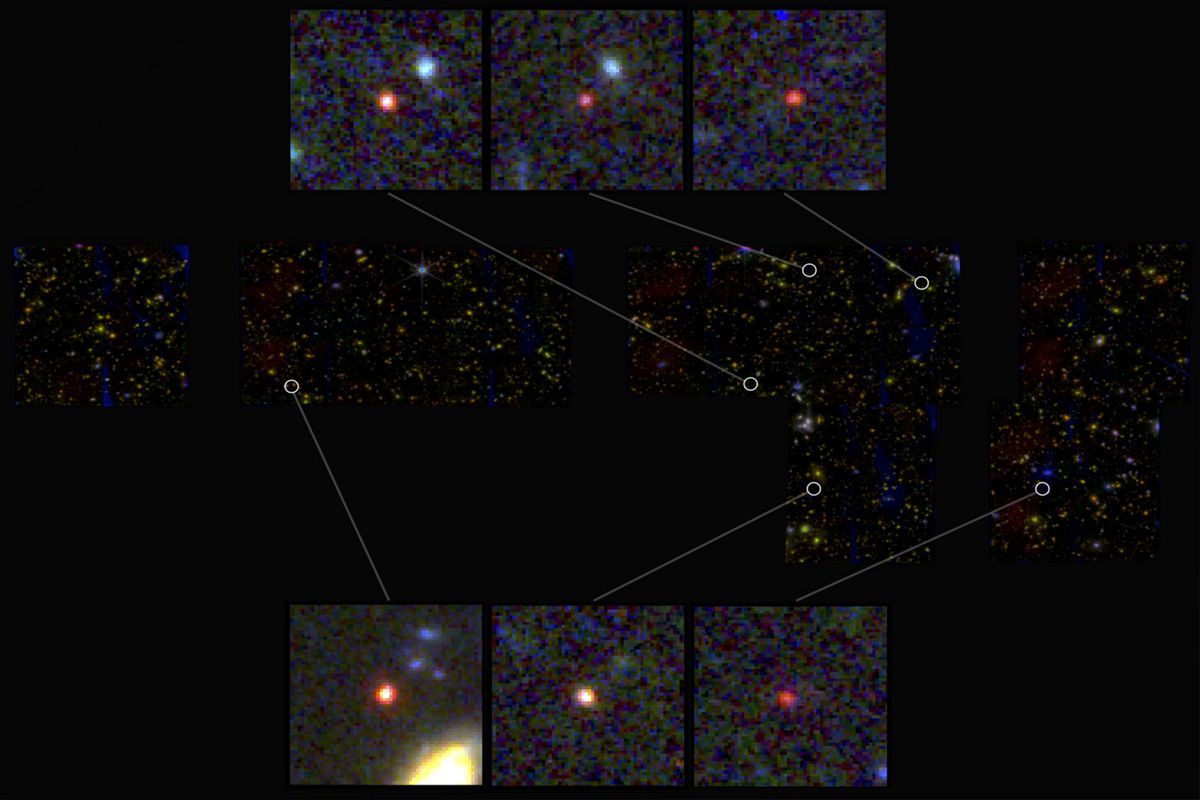The Webb telescope may have discovered six galaxies that shouldn’t exist

The universe is full of mysteries, but its age isn’t one of them. That’s because the universe left behind a huge number of clues as to its age — including the observed age of the oldest stars; the rate of expansion of the universe; and the background heat of the universe, which hints at how long it’s been since it cooled off from the Big Bang. All of these data points, measured many times in different ways, point to a universe that expanded from a single point some 13.7 billion years ago.
But once in a while, something weird comes along that doesn’t fit with that timeline.
That’s the case with a new observation from the James Webb Space Telescope, which observed six massive galaxies whose timeline doesn’t square with the age of the universe.
That’s according to a recent paper in the scientific journal Nature, which found that a sextet of fuzzy blue and red galaxies in a blurry photograph appear older than is physically possible.
“Another possibility is that these things are a different kind of weird object, such as faint quasars, which would be just as interesting.”
Each of these galaxies contains almost as many stars as our own Milky Way galaxy and may have been formed more than 13 billion years ago. This means that they would have been created only 500 to 700 millions years after the Big Bang, which given their size would render them impossible to actually exist based on current theories about the history and workings of the universe.
That said, there are other possible explanations, which the researchers themselves are quick to note, and these too could rewrite astronomy textbooks. The crucial detail is that, because these objects are so distant, future James Webb Space Telescope measurements will need to be taken before a full picture can be painted of their origin.
In the words of first author Ivo Labbé of the Swinburne University of Technology in Australia in a statement, “another possibility is that these things are a different kind of weird object, such as faint quasars, which would be just as interesting.”
As co-author Erica Nelson also pointed out, if these dots are indeed massive galaxies, they operate in a way vastly different from our own.
“The Milky Way forms about one to two new stars every year,” the astrophysics professor at Colorado University Boulder said in a statement. “Some of these galaxies would have to be forming hundreds of new stars a year for the entire history of the universe.”
Want more health and science stories in your inbox? Subscribe to Salon’s weekly newsletter The Vulgar Scientist.
“Almost by definition, when a project like this launches, there are no serious risks left, because you want to address them all before launching.”
These are not the first oddities to be revealed to the world by the James Webb Space Telescope. In July there was a grand unveiling of its first five images, which included SMACS 0723, which was at that time the most clear and full infrared image of the distant universe ever produced; the Southern Ring Nebula, which looked like a jellyfish without tentacles but is in fact a dying star expelling large amounts of mass in waves; Stephan’s quintet, a compact group of galaxies locked in a cosmic dance in the Pegasus constellation; the Carina Nebula, which was brimming with individual stars and emerging stellar nurseries; and a spectrum image of WASP-96 b, a gas giant similar to our solar system’s planet Jupiter — only, in this case, it is orbiting a distant Sun-like star.
The James Webb Space Telescope has also provided scientists with a fascinating new look at Jupiter’s atmosphere, as well as an image of an interstellar nursery known as the Tarantula Nebula which resembles nothing less than a man sitting cross-legged. Many of the released James Webb Space Telescope images have probed to unprecedented depths of the universe and produced pictures with revolutionary levels of clarity and detail.
None of this came easily to the scientists who made the telescope. Nearly two decades were spent tweaking instruments and revamping the machine because, as scientists understood, there would be no second chances once it was launched.
The meticulousness certainly paid off, as new mysteries come to light in the universe as a result of its eagle eye.
Read more
about the James Webb Space Telescope

